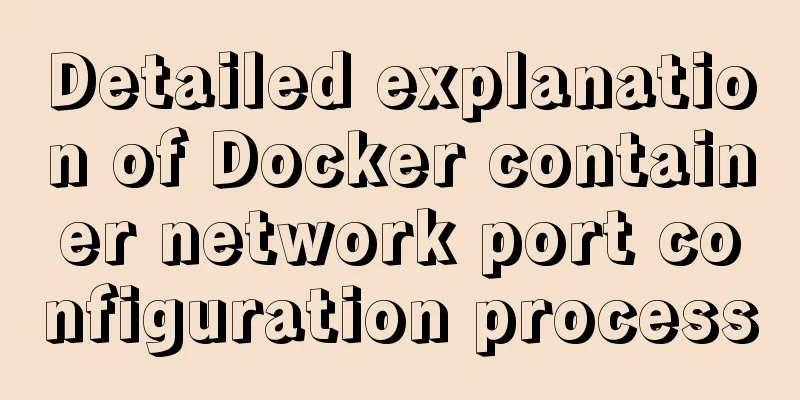Detailed explanation of Docker container network port configuration process

|
Exposing network ports In fact, there are two parameters in Docker that involve exposing network ports, namely -p and -P. The following will introduce them separately. -P With -P, Docker will randomly assign an unused port to the application on the host and map it to the open port in the container. -p The -p parameter has several different uses: hostPort:containerPort This usage is to bind the host port and the container port, as follows:
The above command means mapping port 80 of the host machine to port 80 of the container. The first port 80 is port 80 of the host machine, and the second port 80 is port 80 of the container. ip:hostPort:containerPort This method maps the port of the specified IP address to the port of the container. as follows:
Map port 80 of the 192.168.0.195 address to port 80 of the container. ip::containerPort This method maps a random port of a specified IP address to an open port of a container, as follows
The above is the full content of this article. I hope it will be helpful for everyone’s study. I also hope that everyone will support 123WORDPRESS.COM. You may also be interested in:
|
<<: Detailed process of implementing the 2048 mini game in WeChat applet
>>: MySQL query sorting and paging related
Recommend
MySQL installation tutorial under Windows with pictures and text
MySQL installation instructions MySQL is a relati...
A detailed introduction to the basics of Linux scripting
Table of contents 1. Script vim environment 2. Ho...
Use iframe to display weather effects on web pages
CSS: Copy code The code is as follows: *{margin:0;...
Vue+elementUI component recursively implements foldable dynamic rendering multi-level sidebar navigation
The function has been implemented a long time ago...
Description of the execution mechanisms of static pages and dynamic pages
1. A static page means that there are only HTML ta...
Introduction to the use of html area image hotspots with a list of related properties
The <area> tag is mainly used in image maps...
Case study of dynamic data binding of this.$set in Vue
I feel that the explanation of this.$set on the I...
Docker setting windows storage path operation
When installing Docker on Windows 10, after selec...
What to do if you forget the root password of Mysql5.7 (simple and effective method)
In the previous article, we introduced how to for...
Solution to inserting a form with a blank line above and below
I don't know if you have noticed when making a...
Encapsulate a simplest ErrorBoundary component to handle react exceptions
Preface Starting from React 16, the concept of Er...
CSS style reset and clear (to make different browsers display the same effect)
In order to make the page display consistent betwe...
Node implements search box for fuzzy query
This article example shares the specific code for...
Native JavaScript to implement random roll call table
This article example shares the specific code of ...
What is a MySQL tablespace?
The topic I want to share with you today is: &quo...













